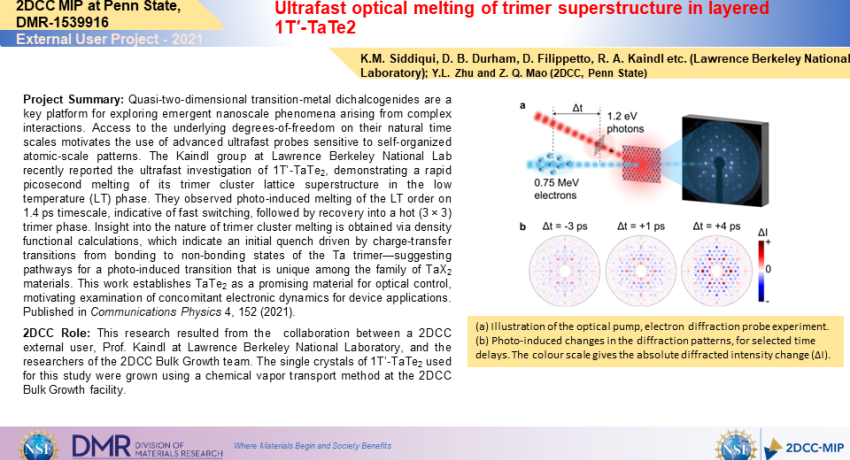Project Summary: Quasi-two-dimensional transition-metal dichalcogenides are a key platform for exploring emergent nanoscale phenomena arising from complex interactions. Access to the underlying degrees-of-freedom on their natural time scales motivates the use of advanced ultrafast probes sensitive to self-organized atomic-scale patterns. The Kaindl group at Lawrence Berkeley National Lab recently reported the ultrafast investigation of 1T’-TaTe2, demonstrating a rapid picosecond melting of its trimer cluster lattice superstructure in the low temperature (LT) phase. They observed photo-induced melting of the LT order on 1.4 ps timescale, indicative of fast switching, followed by recovery into a hot (3 × 3) trimer phase. Insight into the nature of trimer cluster melting is obtained via density functional calculations, which indicate an initial quench driven by charge-transfer transitions from bonding to non-bonding states of the Ta trimer—suggesting pathways for a photo-induced transition that is unique among the family of TaX2 materials. This work establishes TaTe2 as a promising material for optical control, motivating examination of concomitant electronic dynamics for device applications. Published in Communications Physics 4, 152 (2021).
2DCC Role: This research resulted from the collaboration between a 2DCC external user, Prof. Kaindl at Lawrence Berkeley National Laboratory, and the researchers of the 2DCC Bulk Growth team. The single crystals of 1T’-TaTe2 used for this study were grown using a chemical vapor transport method at the 2DCC Bulk Growth facility.
What Has Been Achieved: Demonstrate ultrafast optical melting of trimer superstructure in layered 1T′-TaTe2 .
Importance of the Achievement: Harnessing emergent orders in quantum materials has the potential to revolutionize energy and information
Technologies. Quasi-two-dimensional transition-metal dichalcogenides are a key platform for exploring emergent nanoscale phenomena arising from complex interactions. This work establishes TaTe2 as a promising material for optical control, motivating examination of concomitant electronic dynamics for device applications.
Unique Feature(s) of the MIP that Enabled this Achievement: The 2DCC bulk growth team has not only expertise of crystal growth using various methods, but also capacity of structure and property characterization. Such combination of material growth and characterization enables the 2DCC researchers to grow novel quantum materials which can meet needs of various experiments and attract new users. This collaborative work directly benefits this unique feature of the 2DCC.
(If Applicable) Publication: Khalid M. Siddiqui, Daniel B. Durham, Frederick Cropp, Colin Ophus, Sangeeta Rajpurohit, Yanglin Zhu, Johan D. Carlström, Camille Stavrakas, Zhiqiang Mao, Archana Raja, Pietro Musumeci, Liang Z. Tan, Andrew M. Minor, Daniele Filippetto & Robert A. Kaindl, Communications Physics 4, 152 (2021).
….The financial support for sample preparation was provided by the National Science Foundation through the Penn State 2D Crystal Consortium-Materials Innovation Platform (2DCC-MIP) under NSF cooperative agreement DMR-1539916.
